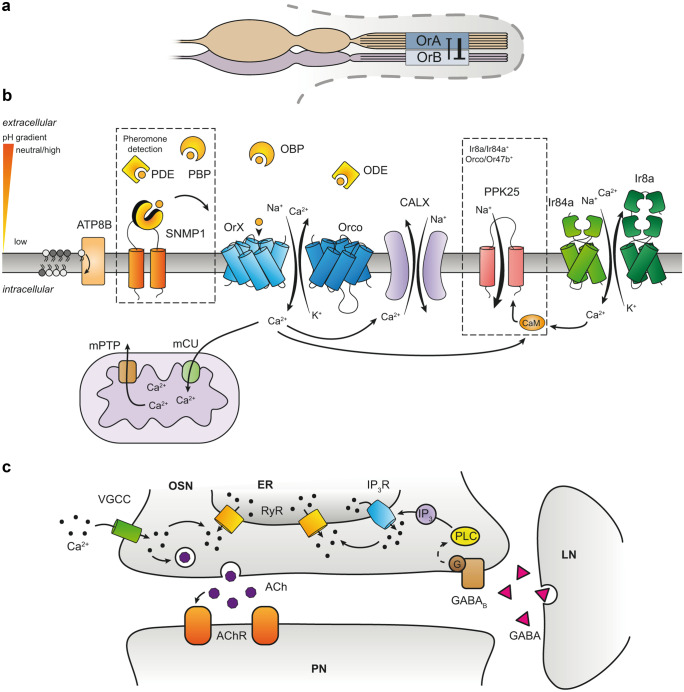Fig. 5.
Additional players in the modulation of insect olfactory receptors response. Several mechanisms add layers of complexity to the modulation of insect olfactory receptors. a Olfactory sensory neurons (OSNs) housed within the same sensillum can differ in their morphology and influence each other’s activity by means of ephaptic interactions (Zhang et al. 2019). b Modulation of olfactory receptors’ activity at the interface between the extracellular sensillum lymph and the cytoplasm. OR-ligand interactions are influenced by odor- and pheromone-binding proteins (OBPs and PBPs) and odor- or pheromone-degradating enzymes (ODEs, PDEs) (Larter et al. 2016; Leal 2013; Xiao et al. 2019). In addition, lipid-derived pheromones can require additional membrane proteins for efficient detection, such as SNMP1 (Gomez-Diaz et al. 2016). Activation of ORs and a subset of IRs, e.g., IR84a, increases the intracellular Ca2+ concentration ([Ca2+]i). In Or47b- or Ir84a-expressing OSNs this [Ca2+]i increase can sensitize the OSN in a CaM-dependent way through the DEG/ENaC channel PPK25 (Ng et al. 2019). Cytoplasmic Ca2+ can be sequestered in the mitochondria through the mitochondrial calcium uniporter (mCU), while Ca2+ can be release from this organelle through the mitochondrial permeability transition pore (mPTP) (Lucke et al. 2020). Moreover, cytoplasmic Ca2+ can be extruded through the Na+/Ca2+ exchanger (CALX) (Halty-deLeon et al. 2018). OR function and/or intracellular trafficking is also affected by other proteins, such as the ATP8B flippase, that is involved in maintaining the phospholipid asymmetry of the plasma membrane (Ha et al. 2014; Liu et al. 2014). c The endoplasmic reticulum (ER) instead plays a role in the adaptation after long-lasting stimuli. After an odor response, the opening of voltage-gated Ca2+ channels (VGCCs) at the presynaptic terminus can lead to the opening of ryanodine receptors (RyRs) and trigger a Ca2+-induced Ca2+ release (CICR). The resulting release of acetylcholine (ACh) stimulates the projection neuron's (PN) ACh receptors (AChRs) and may also activate—directly or indirectly—the release of GABA from associated local interneurons (LN). GABA release can in turn activate the OSN inositol 1,4,5-triphosphate receptors (IP3Rs) via the phospholipase C (PLC) pathway activated by GABAB receptors. The resulting Ca2+ release from the ER can activate RyRs and lead to an additional amplification of the signal through CICR (Murmu et al. 2010, 2011)

